Quantitative Relationships between the Tidal Current Limit, Tidal Level Limit and River Discharge in the Changjiang River Estuary
Abstract
:1. Introduction
2. Methods
2.1. Model Configuration
2.2. Model Validation
2.3. Numerical Experiment
3. Results and Discussion
3.1. Response of Tidal Current Limit to River Discharge Change
3.2. Response of the Tidal Level Limit to River Discharge Change
4. Conclusions
Author Contributions
Funding
Institutional Review Board Statement
Informed Consent Statement
Data Availability Statement
Acknowledgments
Conflicts of Interest
References
- Samoilov. The Theory and Research Method of Estuarine Evolution Process; Science Press: Beijing, China, 1958; pp. 22–30, (In Chinese with English abstract). [Google Scholar]
- Asp, N.E.; Schettini, C.A.F.; Siegle, E.; Da Silva, M.S.; De Brito, R.N.R. The dynamics of a frictionally-dominated Amazonian estuary. Braz. J. Oceanogr. 2012, 60, 391–403. [Google Scholar] [CrossRef] [Green Version]
- Asp, N.E.; Gomes, V.J.C.; Ogston, A.; Borges, J.C.C.; Nittrouer, C.A. Sediment source, turbidity maximum, and implications for mud exchange between channel and mangroves in an Amazonian estuary. Ocean Dyn. 2016, 66, 285–297. [Google Scholar] [CrossRef]
- Asp, N.; Gomes, V.; Schettini, C.; Souza-Filho, P.; Siegle, E.; Ogston, A.; Nittrouer, C.; Silva, J.; Nascimento, W.; Souza, S.; et al. Sediment dynamics of a tropical tide-dominated estuary: Turbidity maximum, mangroves and the role of the Amazon River sediment load. Estuar. Coast. Shelf Sci. 2018, 214, 10–24. [Google Scholar] [CrossRef]
- Freitas, P.T.; Asp, N.E.; Souza-Filho, P.W.M.; Nittrouer, C.A.; Ogston, A.S.; da Silva, M.S. Tidal influence on the hydrodynamics and sediment entrapment in a major Amazon River tributary—Lower Tapajós River. J. South Am. Earth Sci. 2017, 79, 189–201. [Google Scholar] [CrossRef]
- Zhu, J.; Wu, H.; Li, L. Hydrodynamics of the Changjiang Estuary and Adjacent Seas. In Ecological Continuum from the Changjiang (Yangtze River) Watersheds to the East China Sea Continental Margin; Springer International Publishing: Berlin/Heidelberg, Germany, 2015; pp. 19–45. [Google Scholar]
- Shen, H.; Mao, Z.; Zhu, J. Saltwater Intrusion in the Changjiang Estuary; China Ocean: Beijing, China, 2003; (In Chinese with English abstract). [Google Scholar]
- Chen, J.; Yun, C.; Xu, H.; Dong, Y. The Developmental Model of the Chang Jiang River Estuary during last 2000 years. Acta Oceanolgla Sin. 1979, 1, 103–111, (In Chinese with English abstract). [Google Scholar]
- Xu, P.; Liu, K. Tidal level limit and Tidal Current Limit of the Changjiang River. River 1993, 2, 24–39, (In Chinese with English abstract). [Google Scholar]
- Song, L. Research on the Location of Tidal Current Limit of Yantze River. Hydrology 2002, 22, 25–26, (In Chinese with English abstract). [Google Scholar]
- Shi, S.; Cheng, H.; Xuan, X.; Hu, F.; Yuan, X.; Jiang, Y.; Zhou, Q. Fluctuations in the tidal level limit of the Yangtze River estuary in the last decade. Sci. China-Earth Sci. 2018, 61, 1136–1147. [Google Scholar] [CrossRef]
- Shen, H.; Li, J.; Yan, S. Study the Migration of the Tidal Level Limit and the Tidal Current Limit of the Yangtze River under Its Extreme High and Lower Runoff; Chinese-German Joint Symposium on Hydraulic and Ocean Engineering: Hannover, Germany, 2008; pp. 191–197. [Google Scholar]
- Li, J. Tidal Level Limit and Tidal Current Limit & Response to Major Engineering in Yangtze Estuary; East China Normal University: Shanghai, China, 2004; (In Chinese with English abstract). [Google Scholar]
- Shen, H.; Zhu, J.; Wu, H. Interface of the Land Ocean Interactions in the Yangtze Coastal Zone; China Ocean Press: Beijing, China, 2008; pp. 40–54, (In Chinese with English abstract). [Google Scholar]
- Friedrichs, C.T.; Aubrey, D.G. Tidal propagation in strongly convergent channels. J. Geophys. Res. 1994, 99, 3321–3336. [Google Scholar] [CrossRef]
- Unnikrishnan, A.; Shetye, S.; Gouveia, A. Tidal Propagation in the Mandovi–Zuari Estuarine Network, West Coast of India: Impact of Freshwater Influx. Estuar. Coast. Shelf Sci. 1997, 45, 737–744. [Google Scholar] [CrossRef]
- Godin, G. The Propagation of Tides up Rivers with Special Considerations on the Upper Saint Lawrence River. Estuar. Coast. Shelf Sci. 1999, 48, 307–324. [Google Scholar] [CrossRef]
- Lu, C. The Tidal Wave Dissemination in the Yangtze Estuary; Nanjing Hydraulic Research Institude: Nanjing, China, 2009; (In Chinese with English abstract). [Google Scholar]
- Xu, H.; Fan, L.; Gu, M. On Tidal Mark and Tidal Current Mark in the Yangtze River; Port & Waterway Engineering: Chengdu, China, 2012; pp. 15–20, (In Chinese with English abstract). [Google Scholar]
- Lu, C.; Luo, X.; Chen, Z. Study of current limit causing by runoff and tidal range in Yantze River. Eng. J. Wuhan Univ. 2016, 49, 201–205, (In Chinese with English abstract). [Google Scholar]
- Blumberg, A.F. A Primer for ECOM-si; Technical Report; HydroQual, Inc.: Mahwah, NJ, USA, 1994; p. 66. [Google Scholar]
- Wu, H.; Zhu, J.; Choi, B.H. Links between saltwater intrusion and subtidal circulation in the Changjiang Estuary: A model-guided study. Cont. Shelf Res. 2010, 30, 1891–1905. [Google Scholar] [CrossRef]
- Li, L.; Zhu, J.; Wu, H. Impacts of wind stress on saltwater intrusion in the Yangtze Estuary. Sci. China Earth Sci. 2012, 55, 1178–1192. [Google Scholar] [CrossRef]
- Qiu, C.; Zhu, J.; Gu, Y. Impact of seasonal tide variation on saltwater intrusion in the Changjiang River estuary. Chin. J. Oceanol. Limnol. 2012, 30, 342–351. [Google Scholar] [CrossRef]
- Qiu, C.; Zhu, J. Assessing the Influence of Sea Level Rise on Salt Transport Processes and Estuarine Circulation in the Changjiang River Estuary. J. Coast. Res. 2015, 313, 661–670. [Google Scholar] [CrossRef]
- Lyu, H.; Zhu, J. Impact of the bottom drag coefficient on saltwater intrusion in the extremely shallow estuary. J. Hydrol. 2018, 557, 838–850. [Google Scholar] [CrossRef]
- Arakawa, A.; Lamb, V.R. Computational Design of the Basic Dynamical Processes of the UCLA General Circulation Model. Methods Comput. Phys. Adv. Res. Appl. 1977, 17, 173–265. [Google Scholar] [CrossRef]
- Casulli, V. Semi-implicit finite difference methods for the two-dimensional shallow water equations. J. Comput. Phys. 1990, 86, 56–74. [Google Scholar] [CrossRef]
- Smagorinsky, J. General circulation experiments with the primitive equations: I. The basic experiment. Mon. Weather Rev. 1963, 91, 99–164. [Google Scholar] [CrossRef]
- Mellor, G.L.; Yamada, T. A hierarchy of turbulence closure models for planetary boundary layers. J. Atmos. Sci. 1974, 31, 1791–1806. [Google Scholar] [CrossRef] [Green Version]
- Mellor, G.L.; Yamada, T. Development of a turbulence closure model for geophysical fluid problems. Rev. Geophys. 1982, 20, 851–875. [Google Scholar] [CrossRef] [Green Version]
- Wu, H.; Zhu, J. Advection scheme with 3rd high-order spatial interpolation at the middle temporal level and its application to saltwater intrusion in the Changjiang Estuary. Ocean Model. 2010, 33, 33–51. [Google Scholar] [CrossRef]
- Editorial Board for Marine Atlas, Ocean Atlas in Huanghai Sea and East China Sea (Hydrology); China Ocean Press: Beijing, China, 1992.
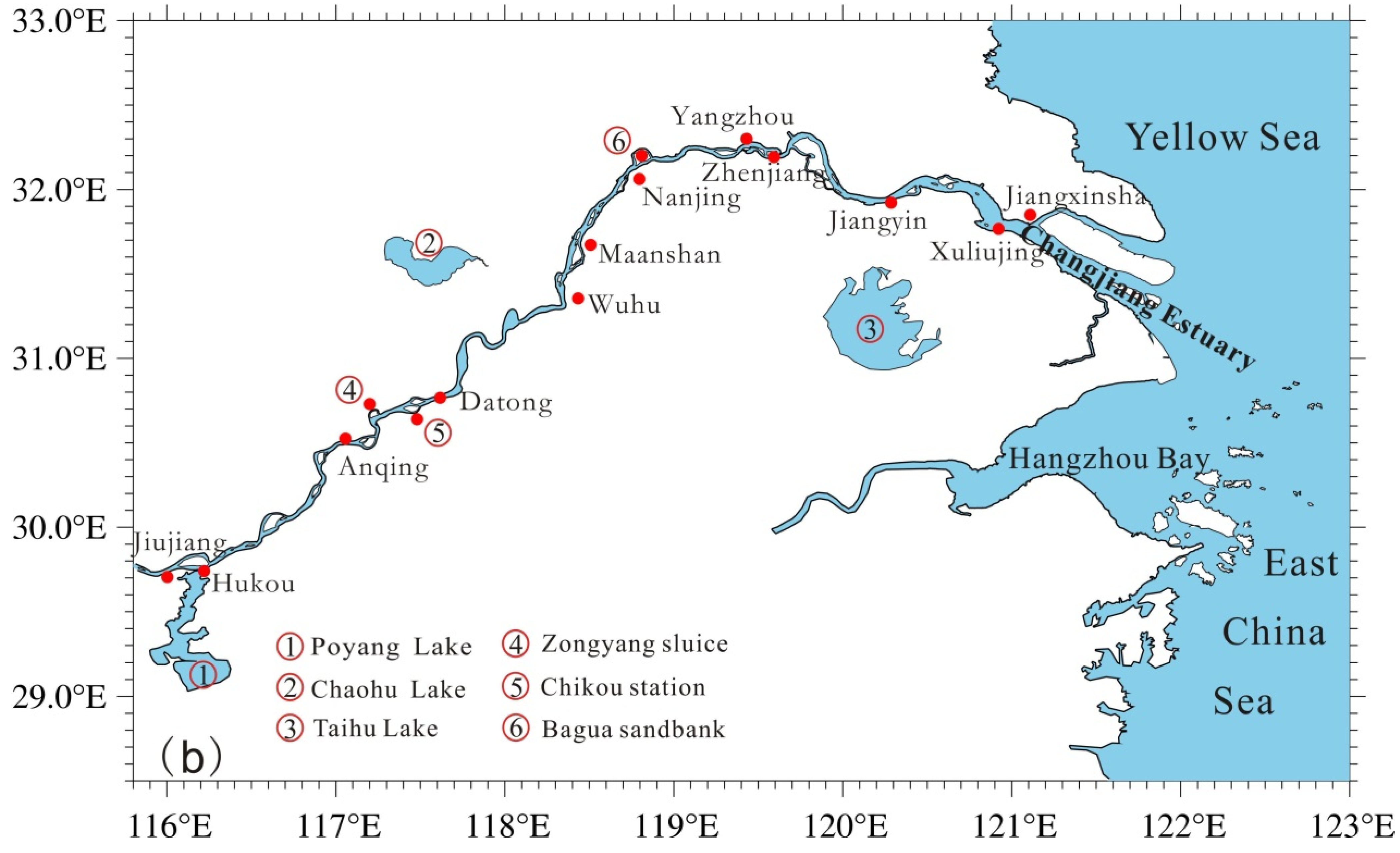

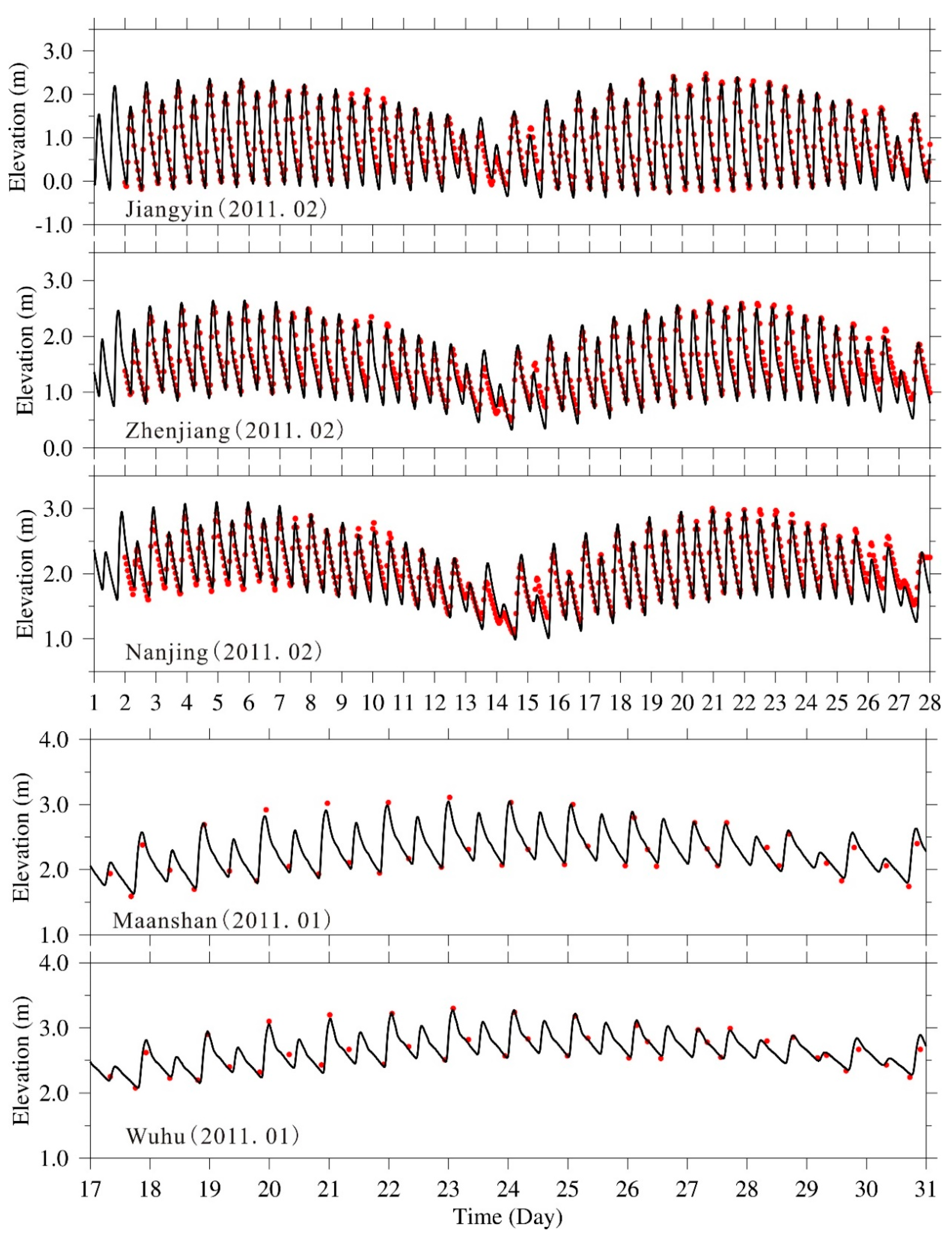

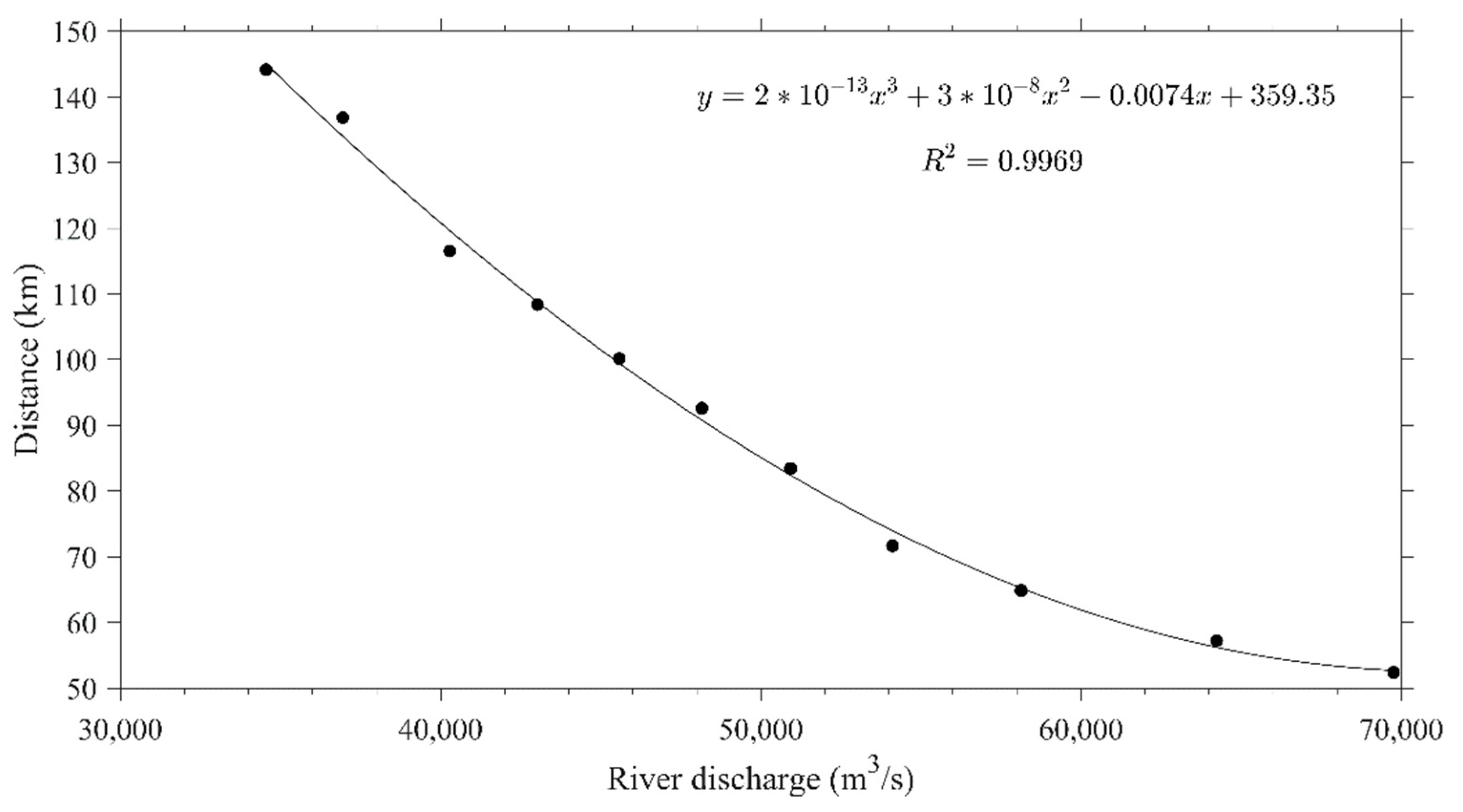
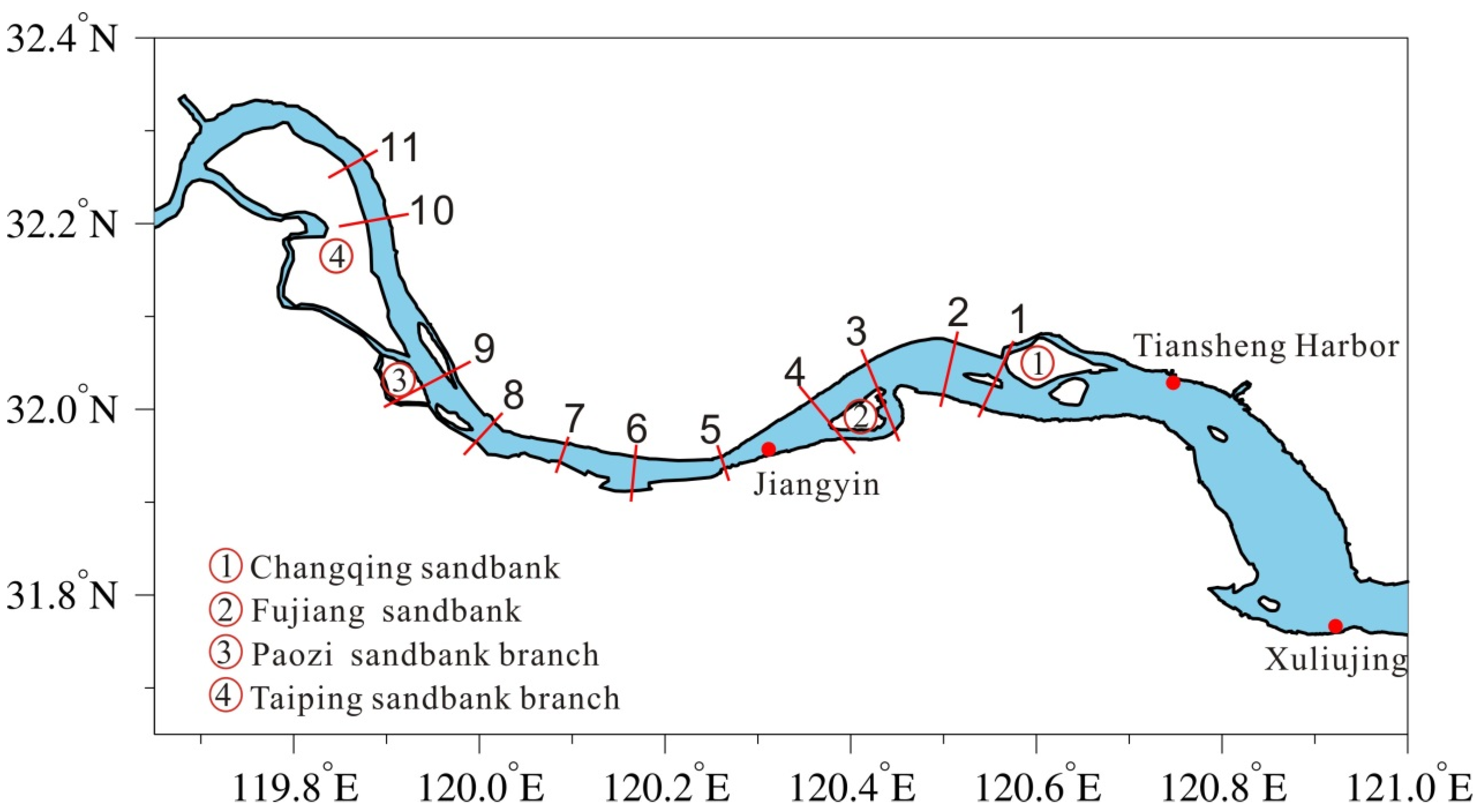
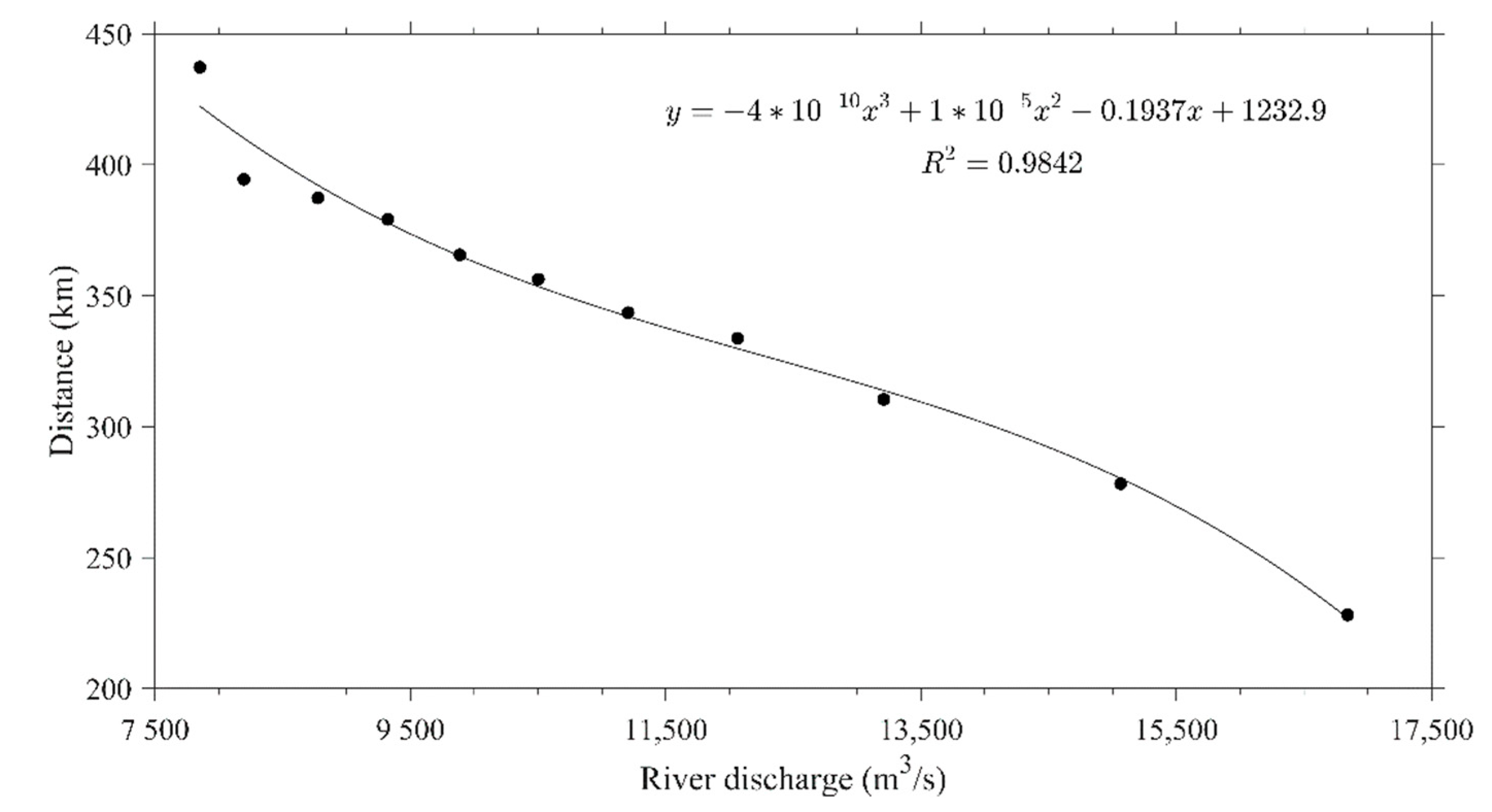
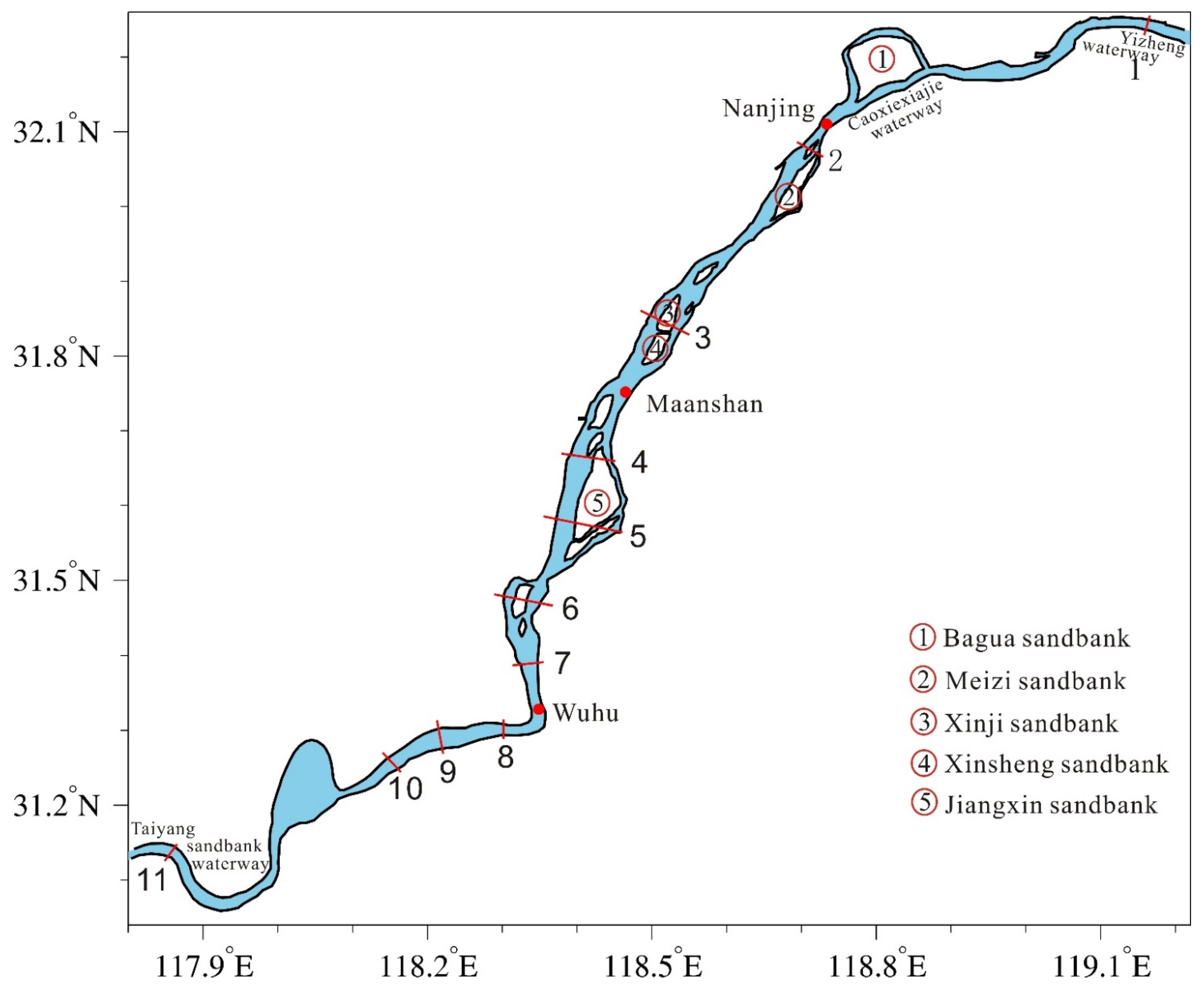
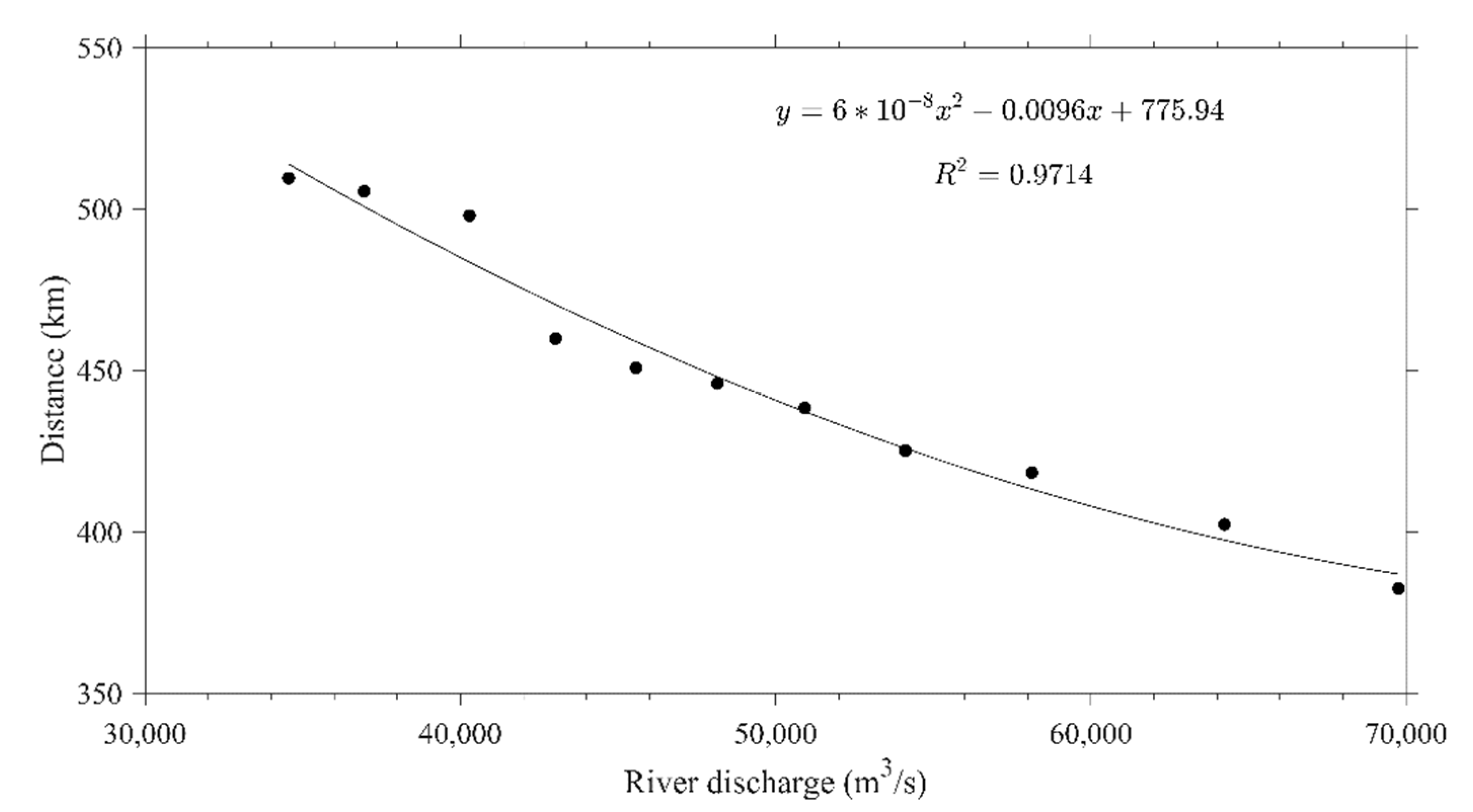
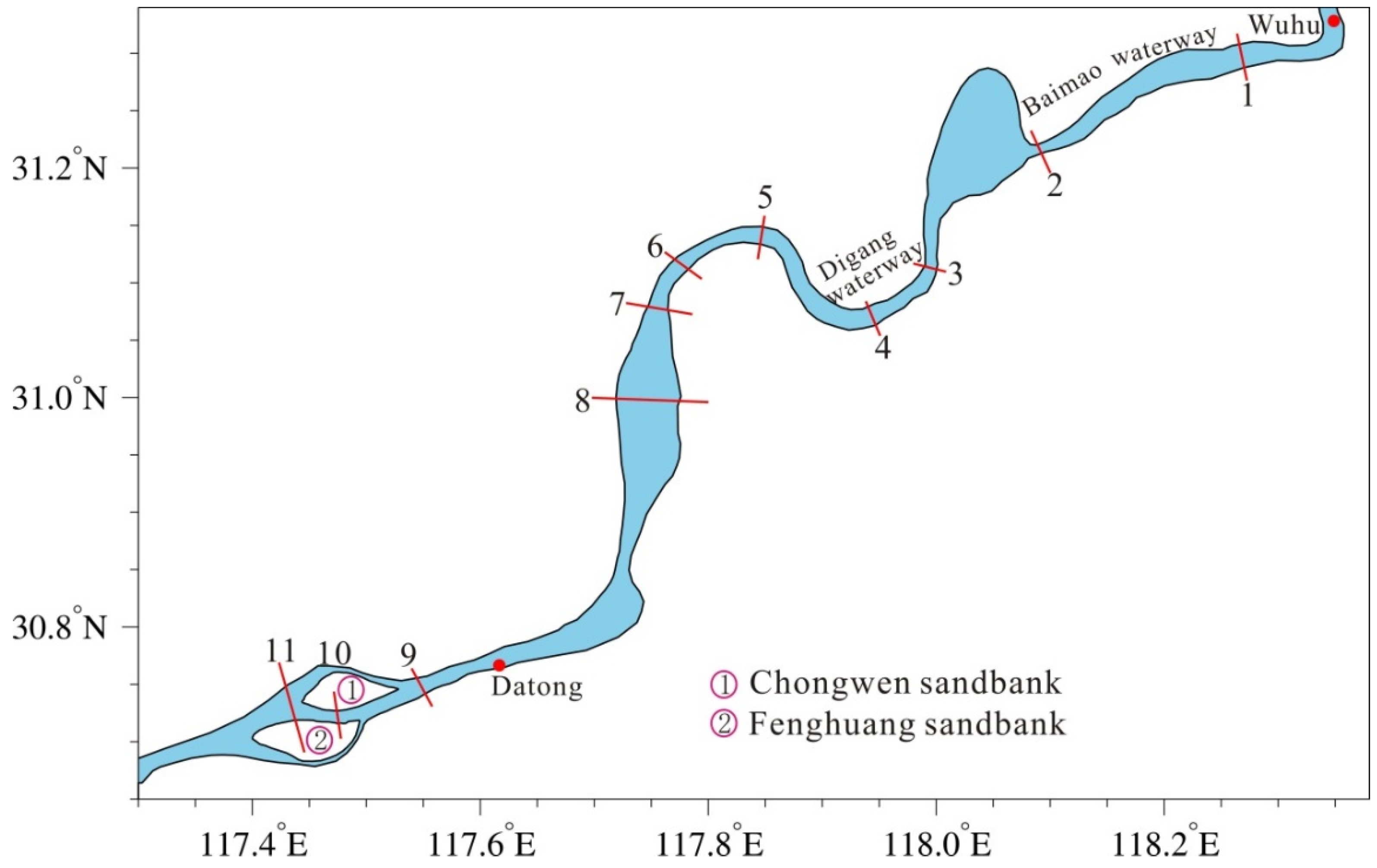
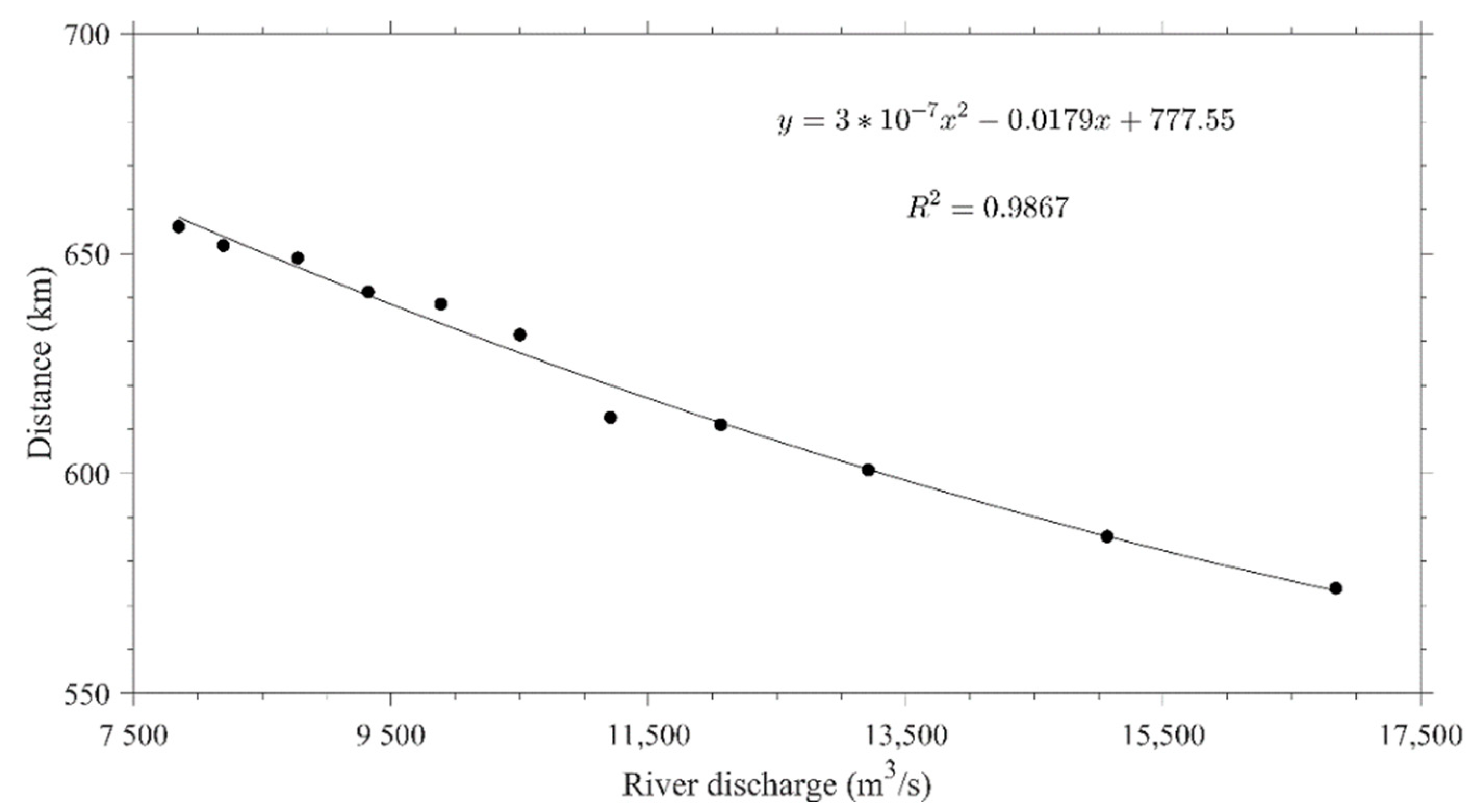
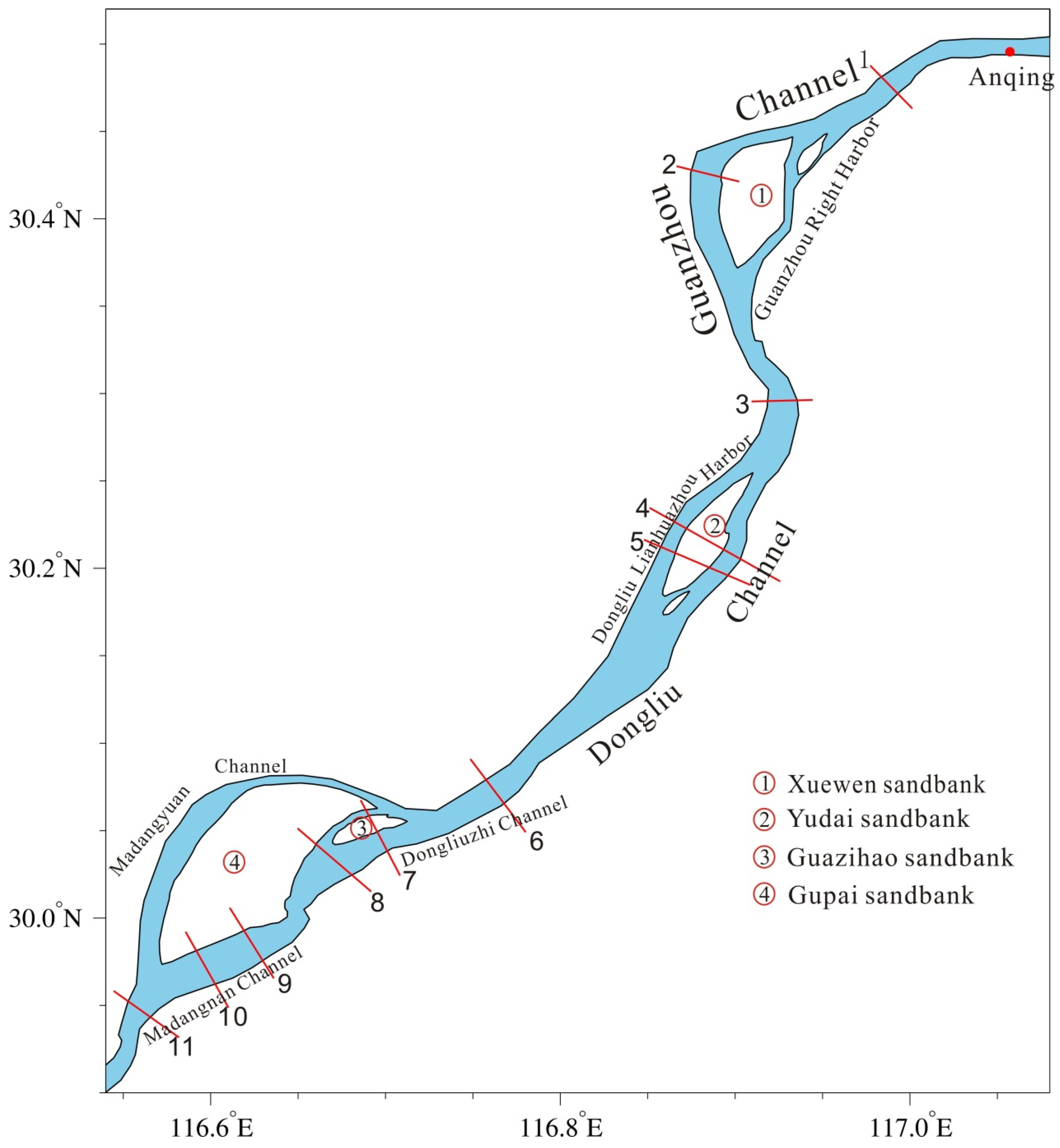
| Frequency (%) | 5 | 10 | 20 | 30 | 40 | 50 | 60 | 70 | 80 | 90 | 95 |
|---|---|---|---|---|---|---|---|---|---|---|---|
| January | 16,842 | 15,065 | 13,209 | 12,063 | 11,206 | 10,503 | 9888 | 9323 | 8776 | 8196 | 7852 |
| July | 69,765 | 64,238 | 58,131 | 54,115 | 50,932 | 48,161 | 45,580 | 43,024 | 40,292 | 36,947 | 34,551 |
Publisher’s Note: MDPI stays neutral with regard to jurisdictional claims in published maps and institutional affiliations. |
© 2021 by the authors. Licensee MDPI, Basel, Switzerland. This article is an open access article distributed under the terms and conditions of the Creative Commons Attribution (CC BY) license (https://creativecommons.org/licenses/by/4.0/).
Share and Cite
Hou, C.; Zhu, J.; Huang, J.; Cheng, X. Quantitative Relationships between the Tidal Current Limit, Tidal Level Limit and River Discharge in the Changjiang River Estuary. J. Mar. Sci. Eng. 2021, 9, 1291. https://doi.org/10.3390/jmse9111291
Hou C, Zhu J, Huang J, Cheng X. Quantitative Relationships between the Tidal Current Limit, Tidal Level Limit and River Discharge in the Changjiang River Estuary. Journal of Marine Science and Engineering. 2021; 9(11):1291. https://doi.org/10.3390/jmse9111291
Chicago/Turabian StyleHou, Chengcheng, Jianrong Zhu, Ju Huang, and Xinyue Cheng. 2021. "Quantitative Relationships between the Tidal Current Limit, Tidal Level Limit and River Discharge in the Changjiang River Estuary" Journal of Marine Science and Engineering 9, no. 11: 1291. https://doi.org/10.3390/jmse9111291
APA StyleHou, C., Zhu, J., Huang, J., & Cheng, X. (2021). Quantitative Relationships between the Tidal Current Limit, Tidal Level Limit and River Discharge in the Changjiang River Estuary. Journal of Marine Science and Engineering, 9(11), 1291. https://doi.org/10.3390/jmse9111291






